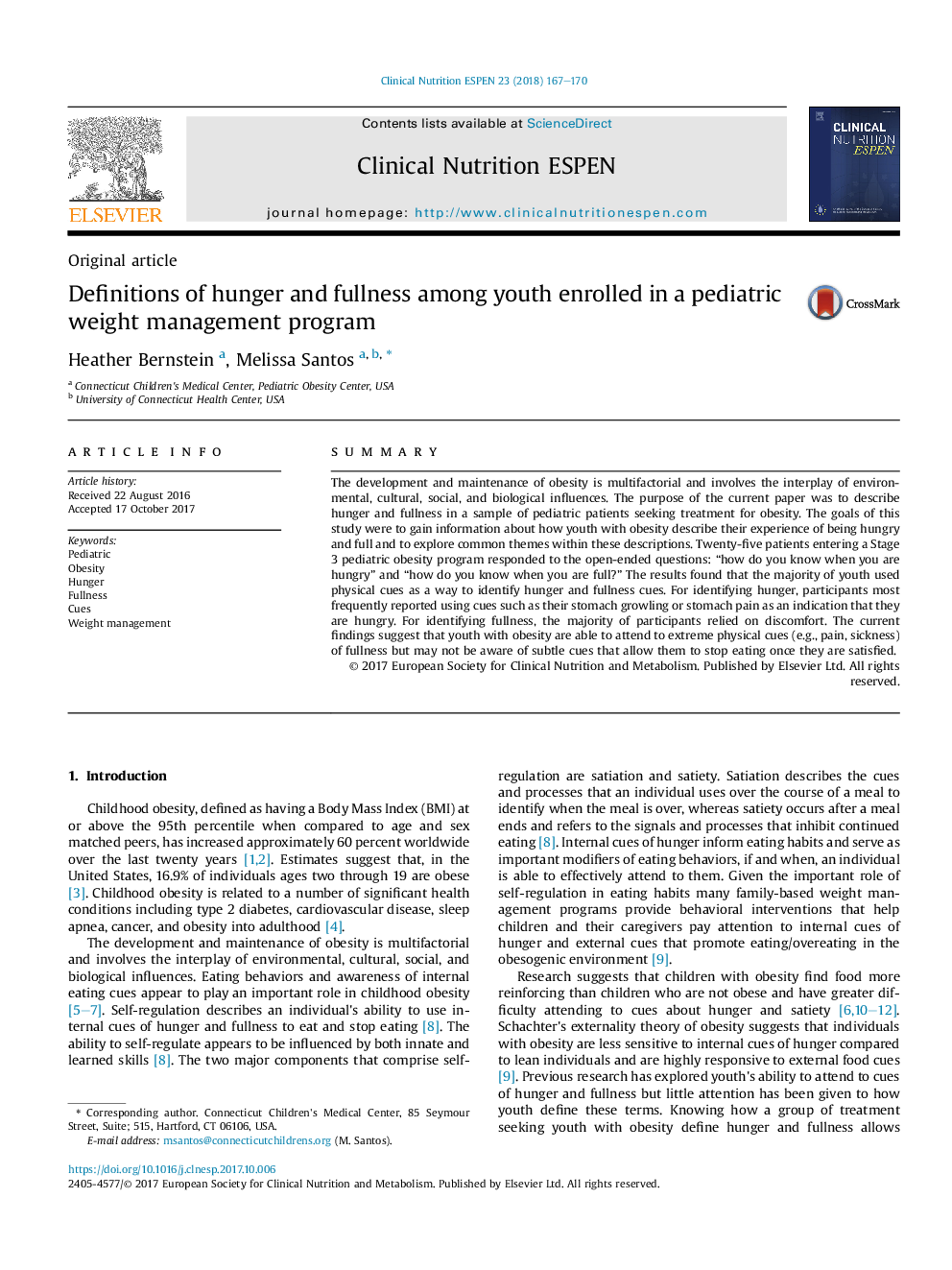| کد مقاله | کد نشریه | سال انتشار | مقاله انگلیسی | نسخه تمام متن |
|---|---|---|---|---|
| 8587541 | 1564716 | 2018 | 4 صفحه PDF | دانلود رایگان |
عنوان انگلیسی مقاله ISI
Definitions of hunger and fullness among youth enrolled in a pediatric weight management program
ترجمه فارسی عنوان
تعاریف گرسنگی و پرستی در میان جوانان ثبت شده در یک برنامه مدیریت وزن کودکان
دانلود مقاله + سفارش ترجمه
دانلود مقاله ISI انگلیسی
رایگان برای ایرانیان
کلمات کلیدی
اطفال، چاقی، گرسنگی، کامل بودن، نشانه، مدیریت وزن،
ترجمه چکیده
توسعه و نگهداری چاقی چند وجهی است و شامل تاثیرات محیطی، فرهنگی، اجتماعی و بیولوژیکی می شود. هدف از مقاله حاضر، توصیف گرسنگی و کامل بودن در نمونه ای از بیماران اطفال برای درمان چاقی بود. اهداف این مطالعه به دست آوردن اطلاعات در مورد چگونگی تجربه جوانان با چاقی از تجربه گرسنگی و کامل و توصیف مفاهیم مشترک است. 25 بیمار ورودی به برنامه چاقی اطفال در مرحله 3 به سوالات باز پاسخ دادند: چگونه می دانید زمانی که گرسنه هستید؟ و چطور می دانید وقتی پر می شود؟ نتایج نشان می دهد که اکثر جوانان از نشانه های فیزیکی به عنوان راهی برای شناسایی گرسنگی و نشانه های پریشانی استفاده می کنند. برای شناسایی گرسنگی، مشارکتکنندگان اغلب با استفاده از نشانهها مانند ریشخورد معده و درد معده به عنوان نشانه ای از گرسنگی گزارش می دهند. برای شناسایی کامل بودن، اکثر شرکت کنندگان به ناراحتی متکی بودند. یافته های کنونی نشان می دهد که جوانان دارای چاقی می توانند در نشانه های شدید فیزیکی (مثلا درد، بیماری) پرستی شرکت کنند اما ممکن است از نشانه های ظریف آگاه نباشند که به آنها اجازه می دهد از خوردن غذا لذت ببرند.
موضوعات مرتبط
علوم پزشکی و سلامت
پزشکی و دندانپزشکی
مراقبت های ویژه و مراقبتهای ویژه پزشکی
چکیده انگلیسی
The development and maintenance of obesity is multifactorial and involves the interplay of environmental, cultural, social, and biological influences. The purpose of the current paper was to describe hunger and fullness in a sample of pediatric patients seeking treatment for obesity. The goals of this study were to gain information about how youth with obesity describe their experience of being hungry and full and to explore common themes within these descriptions. Twenty-five patients entering a Stage 3 pediatric obesity program responded to the open-ended questions: “how do you know when you are hungry” and “how do you know when you are full?” The results found that the majority of youth used physical cues as a way to identify hunger and fullness cues. For identifying hunger, participants most frequently reported using cues such as their stomach growling or stomach pain as an indication that they are hungry. For identifying fullness, the majority of participants relied on discomfort. The current findings suggest that youth with obesity are able to attend to extreme physical cues (e.g., pain, sickness) of fullness but may not be aware of subtle cues that allow them to stop eating once they are satisfied.
ناشر
Database: Elsevier - ScienceDirect (ساینس دایرکت)
Journal: Clinical Nutrition ESPEN - Volume 23, February 2018, Pages 167-170
Journal: Clinical Nutrition ESPEN - Volume 23, February 2018, Pages 167-170
نویسندگان
Heather Bernstein, Melissa Santos,
